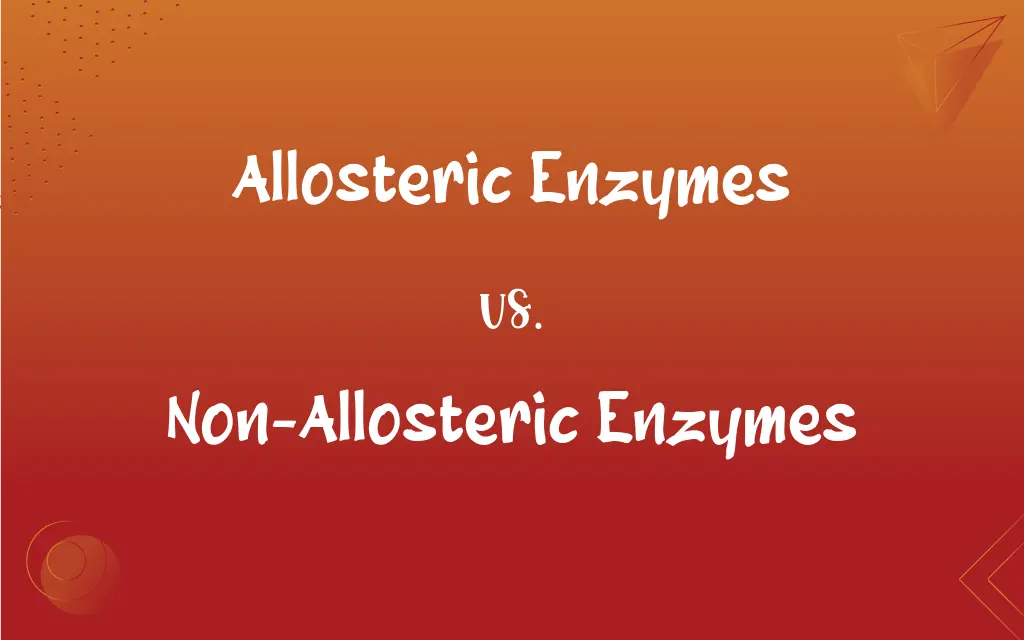Allosteric Enzymes vs. Non-Allosteric Enzymes: What's the Difference?
Edited by Aimie Carlson || By Harlon Moss || Published on March 4, 2024
Allosteric enzymes are regulated by molecules binding at sites other than the active site, altering activity; non-allosteric enzymes lack such regulatory sites and have consistent activity.

Key Differences
Allosteric enzymes are unique in their regulation, as they have sites for molecules to bind other than their active sites, known as allosteric sites. This binding alters the enzyme's shape and activity. In contrast, non-allosteric enzymes do not possess these regulatory sites and thus maintain a consistent level of activity without such regulatory influences.
The functionality of allosteric enzymes is often essential in metabolic pathways, as their activity can be fine-tuned by the presence of specific molecules, allowing for dynamic control of metabolic processes. Non-allosteric enzymes, however, work at a constant rate, determined only by their concentration and substrate availability, making them more predictable but less adaptable.
Allosteric enzymes can be either activated or inhibited by their allosteric modulators, offering a versatile mechanism of metabolic regulation. Non-allosteric enzymes, lacking this modulation mechanism, rely solely on their inherent kinetic properties and substrate concentrations for their activity.
The structural complexity of allosteric enzymes allows for the integration of multiple signals, enabling a coordinated response to cellular needs. Non-allosteric enzymes, simpler in structure, do not have this capability, functioning independently of such regulatory signals.
Allosteric enzymes are key regulatory elements in cellular metabolism, responsive to various biochemical signals. Non-allosteric enzymes, while essential for metabolic processes, operate without such regulation, maintaining steady activity levels.
ADVERTISEMENT
Comparison Chart
Regulation
Regulated by molecules binding at allosteric sites
Lack allosteric sites, not regulated by such binding
Activity Control
Activity can be dynamically altered (activated or inhibited)
Activity is consistent, unaffected by external modulators
Structural Complexity
Often structurally complex due to additional binding sites
Structurally simpler, without additional regulatory sites
Role in Metabolism
Key in metabolic regulation, responsive to cellular signals
Operate at a steady rate, independent of such signals
Functional Adaptability
Highly adaptable to cellular needs and conditions
Less adaptable, function based on kinetic properties alone
ADVERTISEMENT
Allosteric Enzymes and Non-Allosteric Enzymes Definitions
Allosteric Enzymes
Allosteric enzymes have a quaternary structure, allowing them to assume different shapes based on effector binding.
Hemoglobin acts as an allosteric enzyme in oxygen transport, changing shape upon oxygen binding.
Non-Allosteric Enzymes
They lack the structural complexity for allosteric regulation and have a singular active site.
Lipase, a non-allosteric enzyme, hydrolyzes fats without being influenced by regulatory molecules.
Allosteric Enzymes
An enzyme whose activity is modulated by the binding of an effector molecule at a site other than the active site.
In glycolysis, phosphofructokinase, an allosteric enzyme, is inhibited by ATP, slowing down the pathway when energy is abundant.
Non-Allosteric Enzymes
Operate independently of cellular metabolic signals, maintaining steady activity.
Sucrase, a non-allosteric enzyme, consistently breaks down sucrose, unaffected by the cell's energy status.
Allosteric Enzymes
These enzymes are central to feedback inhibition in metabolic pathways.
In the synthesis of isoleucine, threonine deaminase, an allosteric enzyme, is inhibited by isoleucine, preventing excess production.
Non-Allosteric Enzymes
Non-allosteric enzymes function based solely on substrate concentration and inherent kinetic properties.
Catalase, a non-allosteric enzyme, decomposes hydrogen peroxide at a rate dependent only on its concentration.
Allosteric Enzymes
Allosteric enzymes can exist in active and inactive forms, controlled by allosteric regulators.
Aspartate transcarbamoylase, an allosteric enzyme, is activated by ATP and inhibited by CTP, balancing nucleotide synthesis.
Non-Allosteric Enzymes
These enzymes do not participate in feedback inhibition or activation by effector molecules.
Ribonuclease, a non-allosteric enzyme, cleaves RNA molecules without being regulated by metabolic feedback.
Allosteric Enzymes
They play a crucial role in the regulation of pathways by sensing changes in the cell's environment.
In response to high glucose levels, the allosteric enzyme glucokinase becomes more active, increasing glucose utilization.
Non-Allosteric Enzymes
Enzymes that operate at a consistent rate, unaffected by molecules binding at sites other than the active site.
Amylase, a non-allosteric enzyme, consistently breaks down starch into sugars irrespective of cellular energy levels.
FAQs
What distinguishes non-allosteric enzymes from allosteric ones?
They lack regulatory sites and have consistent activity levels.
What is the role of non-allosteric enzymes in metabolism?
They perform essential reactions at a constant rate, independent of regulation.
What are allosteric enzymes?
Enzymes regulated by molecules binding at non-active sites, altering their activity.
Can allosteric enzymes be inhibited or activated?
Yes, they can be either inhibited or activated by different molecules.
Are non-allosteric enzymes affected by changes in the cell?
No, they function consistently regardless of cellular conditions.
What is an example of an allosteric enzyme in the body?
Hemoglobin, regulating oxygen transport.
Give an example of a non-allosteric enzyme.
Amylase, consistently breaking down starch.
How does effector binding alter allosteric enzymes?
It changes their shape, affecting their activity.
How do allosteric enzymes regulate metabolic pathways?
By changing activity in response to specific molecules, facilitating dynamic control.
Do non-allosteric enzymes have feedback inhibition?
No, they do not participate in feedback inhibition.
Are allosteric enzymes specific to eukaryotes?
No, they are found in both eukaryotes and prokaryotes.
Are allosteric enzymes common in cellular processes?
Yes, they are vital in regulating various metabolic pathways.
Can non-allosteric enzymes be part of a multi-enzyme complex?
Yes, but their activity in the complex is not regulated allosterically.
How do allosteric enzymes contribute to homeostasis?
By adjusting their activity in response to cellular needs, maintaining balance.
Do changes in pH affect non-allosteric enzyme activity?
Yes, like most enzymes, their activity can be influenced by pH changes.
How do substrate concentrations affect non-allosteric enzymes?
Their activity solely depends on substrate concentration.
Do non-allosteric enzymes require cofactors for activity?
Some may require cofactors, but not for regulatory purposes.
What is an allosteric inhibitor?
A molecule that binds to an allosteric site, reducing enzyme activity.
What factors affect the activity of non-allosteric enzymes?
Primarily substrate concentration and environmental conditions like pH and temperature.
What is the structural difference between allosteric and non-allosteric enzymes?
Allosteric enzymes are structurally complex with additional binding sites.
About Author
Written by
Harlon MossHarlon is a seasoned quality moderator and accomplished content writer for Difference Wiki. An alumnus of the prestigious University of California, he earned his degree in Computer Science. Leveraging his academic background, Harlon brings a meticulous and informed perspective to his work, ensuring content accuracy and excellence.
Edited by
Aimie CarlsonAimie Carlson, holding a master's degree in English literature, is a fervent English language enthusiast. She lends her writing talents to Difference Wiki, a prominent website that specializes in comparisons, offering readers insightful analyses that both captivate and inform.































































